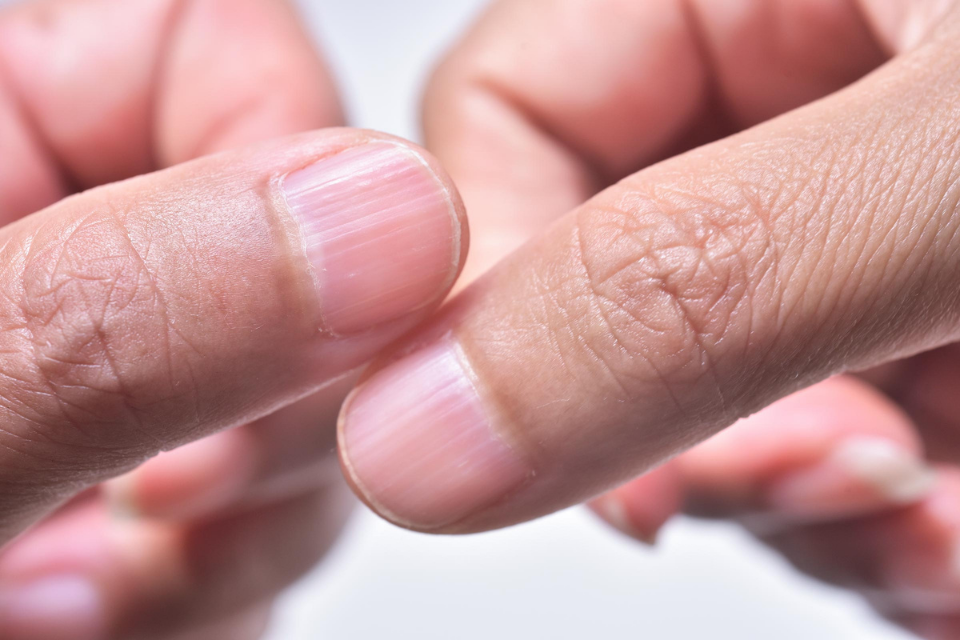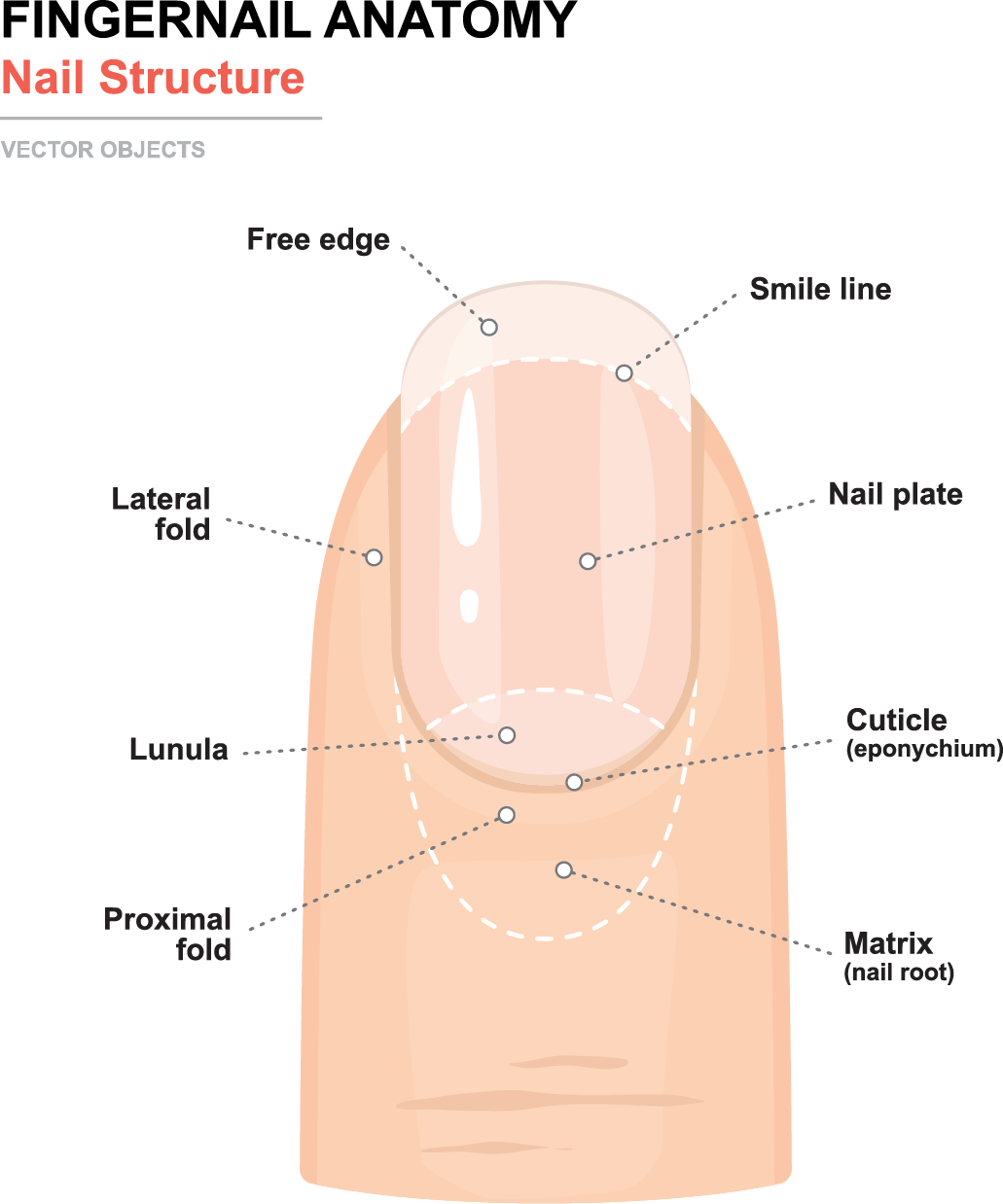
Horizontal ridges on the nails can represent very benign causes. The most common cause of horizontal ridges on the nails is called “Beau’s lines.” Horizontal ridging of the nails is trauma to the nail matrix, which is located just behind the cuticle. There are also a few, rarer nail conditions that can portend liver or kidney issues. Nail changes are worth getting checked out by a board-certified dermatologist.
People are often surprised to learn how frequently nail changes can be associated with different medical conditions. Whether it’s color changes, lines (vertical or horizontal), splitting of the nails, small ‘pits’, or even changes in nail shape, there are thousands of different reasons why your nail might be looking strange compared to what you’re used to. Some of these reasons can be very serious, life-threatening and require immediate medical consultations, such as nail melanoma. Other changes, such as splitting of the ends of nails or some superficial white dots, can be related to mild physical damage from washing hands or getting manicures. In this article, we’re going to talk about horizontal nail ridges (also known as ‘Beau’s lines’); why they happen, what can cause them, and how to treat them.
In order to understand the cause of horizontal nail ridges, it helps to get an idea of how our nails usually grow. Take a look down at your fingernails. Where do you think the nail itself actually grows from?

So, we’re going to give you a little bit of a nail anatomy lesson! The part we talk about as the ‘fingernail’, the part we feel as hard, shiny, and where we apply nail polish etc. is more appropriately referred to as the ‘nail plate’. This is the top most layer of the nail.
Underneath the nail plate is something called the ‘nail bed’, the part that gives the nail its ‘red’ appearance (try squeezing your nail and seeing it switch from pale white to red). This is the part.
Now let’s talk about the really crucial part of the nail… the nail matrix. This is located underneath the skin at the base of the nail (the part BEFORE the nail cuticle towards the rest of your finger). The nail matrix is actually the place where the nail plate grows from! Even though it’s not visible, it’s really the unsung hero of the fingernail.
Fingernails usually grow at a rate of around 1mm per week. So every month, you are getting around 3-4mm of new nail becoming visible at the base close to the cuticle. This pushes the rest of the nail further out beyond the edge of the finger, and then we clip the old, overhanging parts when they start to bother us.
Now that we understand how a nail normally grows, we can move into explaining what exactly causes the horizontal ridges we sometimes see in nails. The nail matrix that builds our nails is made up of special cells that are supplied by a rich number of blood vessels. This means that, whenever there are periods of ‘stress’ on the body, such as an illness, pregnancy/delivery, or certain medications like chemotherapy in the body, these special nail matrix cells are sensitive to these changes. They can damage the ability of the nail matrix to produce the nail plate, and therefore, for a period of time, the matrix cells aren’t feeling themselves and they start to produce less thick/healthy nail. Over time, the stressor on the body fades away, and the cells go back to making thick nails as before. BUT, the evidence of that ‘stress’ phase on the body can still be seen by us when we look at the nail plate! We see the horizontal depressions/ ridges for many months afterwards, until enough new, healthy, nail has grown out and the ridged area gets cut off!
As we mentioned in the previous paragraph, these ridges coincide with periods of ‘stress’ on the body. Most commonly, we see them in our clinics as a response to periods of illness, pregnancy/childbirth, and ESPECIALLY in those who have taken a chemotherapy medication.
The other very common cause of Beau’s lines is some type of mechanical or physical trauma to the cells of the nail matrix. This can be something falling onto the end of your finger, getting your finger trapped in a door, a very aggressive manicure that pushes vigorously on your nail cuticle etc. or anything else that causes physical damage to the nail matrix cells!
This is a tough one. As you can imagine, once there has been a period of trauma and the nail matrix cells have sent some thin nail plate out of the factory, there’s really no way of recalling it and adding on another layer afterwards! This may be annoying to hear for those of you desperately hoping for a fix, but it really is just going to take time, and avoiding other potential ‘stressors’ or damage to the nail matrix cells as best as possible! The expectation would be that, after a few months, your nail would grow back to it’s usual state, so try your best to be patient!
Nail conditions can be VERY tough to tell apart. For example, different combinations of nail color changes and ridging (horizontal, longitudinal) have all sorts of different names. Here’s an example of just some:
While a Google search is good, and reading THIS article is EVEN BETTER, it is very tough to be sure of exactly what nail condition you have just by reading online/checking Google images. Even a ‘general doctor’ who has multiple years of medical school and residency training would see this list of words above for nail changes and feel like they were reading a foreign language.
Because some of these nail changes can be specifically associated with internal medical conditions e.g. liver damage, kidney failure, lung disease, psoriasis, alopecia areata etc. it really is a great idea to get your nail changes checked out by a dermatology specialist (hey, wait a minute, isn’t that OUR name…?)
If you’re in the New York area, we have a TDS location that is convenient for you, takes walk-ins, is open weekends and evenings, and takes the VAST majority of insurances. Try booking an appointment on our website now to get the specific nail condition answers you’re looking for!